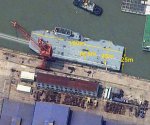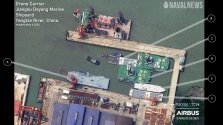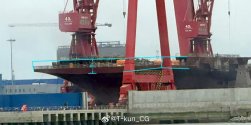There is no such requirement.
So I suppose that warplanes landing on the flight decks of aircraft carriers since the interwar period just clipped their wings against the island superstructures?
The front part of the deck was used for parking and launch at the straight deck design. Failing to catch the arresting cable could result in a crash on the front deck.
Central line landing is an easier approach for landing. Of course, the wing span needs to be limited, with 25 wide runway for a maximum 15m wide jet, or 18m wide for a low-speed drone.
I don't think you realize just how massive the wingspans of UCAVs of substantial sizes and capabilities can be - And why they are designed as such in the first place.
In fact, this applies to literally every carrier-based aircraft that have ever existed.
PLAN already has a central line landing ship built to experiment.
And here're the dimensions of the ship itself.

Sorry to disappoint, but 16.5 meters is
nowhere near being enough to conduct your so-called "centerline landing" while having simultaneous takeoff operations on the exact same flight deck towards the front. And we haven't even talked about the length of the flight deck itself, which even the Mojave STOL-capable UAV would struggle very hard to land without going over the bow and into the water.
In fact,
nobody around the world does that. And there are plenty of good reasons why nobody chooses the flight deck layout design of the cancelled USS United States CV.
Therefore, warship designers are left with two choices - Either the aircraft carriers have angled deck designs to enable simultaneous landing and launching operations (i.e. by directing the landing warplane at a sufficient angle away from other warplanes that are parked/being launched towards the front of the flight deck), or they must accept having only one of the two operations undertaken at any given time with a straight deck design.





